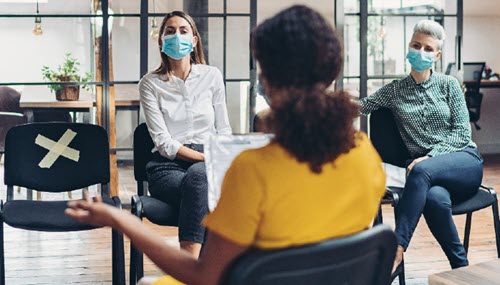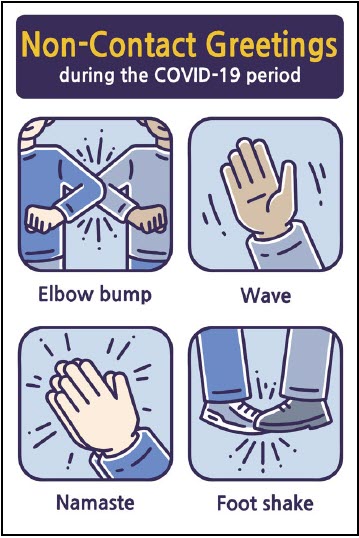COVID-19 Next Steps: Bringing Employees Back to the Workplace
Posted on 06/24/21 by PMA Companies
For some time now, businesses have adjusted their work environments so that the operations in their facilities could continue during the COVID-19 pandemic. Employees were either transitioned to a “work from home” environment or experienced other employment disruptions.
While the pandemic continues to alter the way the world and businesses operate, the tide is slowly turning due to the introduction of vaccines. In addition, many people have developed antibodies from having previously contracted the virus. Social distancing and mask wearing have also impacted the curve. Because of this, businesses are now considering how to bring workers back into their facilities.
Whether you are bringing all of your employees back at once, returning in phases, or switching to a hybrid work model, it is essential to properly prepare your work environment prior to employees’ return.
Communication and Training
It is up to the discretion of each organization to choose whether or not to require employees to be vaccinated before returning to the workplace. What is clear is the importance of being totally transparent in your prevention controls and protocols implemented as you establish your “new normal.” Clear communication and implementing change management techniques are essential. Examples of change management techniques include:
- establishing back-to-the-facility change “champions” who can conduct tours and share instructions for using the work space, especially as it has been newly reconfigured for social distancing; and
- posting and/or sharing a variety of change communication documents, such as “Frequently Asked Questions” postings and “Stay-Safe Etiquette” guides.
PMA is proud of our longstanding commitment to protecting the health and safety of our employees and clients. We are here to support you. If you have any questions or require additional information, please contact your local PMA Risk Control Consultant or email us at heretohelp@pmagroup.com.
Ventilation
Considering the fact that the coronavirus is primarily an airborne virus, proper ventilation in your building is key to reducing exposures as employees return to the workplace. According to the CDC, fine droplets of SARS-CoV-2 (the virus that causes COVID-19) can remain suspended in the air for minutes to hours. Therefore, employees who spend a prolonged period of time (from minutes to several hours) in a space could be exposed when walking through an area. This risk of transmission is increased in situations where people are shouting, singing, or breathing heavily.
Consider the following before returning employees back to an office environment:
- Inspect systems that may have been idled during the past year. Ensure you have properly functioning heating, ventilation, and air conditioning systems to ensure proper airflow and ventilation.
- The system should be run at max outside airflow for two hours before and after occupied times.
- Consult a qualified HVAC contractor or your building engineer to increase the percentage of outdoor air that the system uses. Another consideration would be opening windows and doors to let outside air in.
- Use portable high-efficiency particulate air (HEPA) fans and air purifiers to clean the air in areas where employees tend to congregate.
Other Considerations
Social Distancing
Evaluate and, if necessary, adjust how cubicles, tables and desks are arranged to facilitate 6’ social distancing. Installing higher panels between workstations or re-orienting workstations so that employees do not face one another may be a consideration. It is important to manage layouts so that employees can move safely around the work environment without needing to congregate at entrances or in common areas.
Workstations
Limit or remove personal items for thorough work surface cleaning. Remove chairs or even monitors to discourage unoccupied workstation use. Seating should remain assigned until the widespread threat of virus transmission has diminished.
Conference Rooms
Some states and municipalities may still be setting limits to maximum gatherings, so check with your local government to ensure compliance. Remove extra conference room chairs and install signage indicating the maximum number of people allowed in each conference room. Consider using a portion of your largest conference room for chair storage but ensure chairs or other equipment do not block or obstruct egress, manual pull stations, or fire extinguishers.
Water
Flow water through the potable water lines for an extended period of time. Water that sits stagnant in water mains, building plumbing lines, and water heaters loses residual chlorine disinfectant and increases the risk of waterborne pathogens such as Legionella colonization.
Reception Area
Control access to the office via signage for phone-in entry. Temporary plexiglass “sneeze guard” screens can be installed at reception or check-in points. Rearrange or take away seating in the reception area to manage social distancing. Remove magazines, corporate swag, or pens from the reception space to maintain hygiene. Also, keep the hand sanitizer dispensers in plain view and offer masks if required in your workplace.
Elevators
Limit elevator capacity in terms of the number of riders. One to two riders should be considered the limit at this time.
Restrooms
Depending on the size of your restroom facilities, consideration may be needed to determine if capacity limits are required.
Masks
The CDC is continually changing its guidance on wearing masks. Visit here for the most current recommendations.
Signage
Use visual aids to remind employees of safety measures such as mask wearing, handwashing and distancing.
Housekeeping and Cleaning
Increase “during the day” housekeeping, maintaining a visible presence so employees see the efforts of the organization to keep them healthy and safe.
Virtual Meetings
Virtual meeting platforms have become a part of our lives over the past year and will continue to keep people connected professionally and personally. Encouraging virtual meeting attendance even while in the office may be recommended until the virus transmission has subsided.


